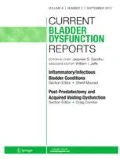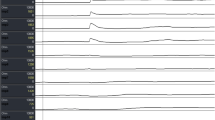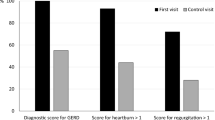Abstract
Overactive bladder (OAB) and urinary incontinence are common in patients with dementia. The etiology is likely multifactorial making it very challenging to treat. Furthermore, the use of anticholinergics, the mainstay of medical management of OAB, in patients with dementia is controversial. The optimal treatment strategy requires setting realistic goals and communicating with family members and care providers.
Similar content being viewed by others
References
Papers of particular interest, published recently, have been highlighted as: • Of importance •• Of major importance
Hellstrom L, Ekelund P, Milsom I, et al. The influence of dementia on the prevalence of urinary and fecal incontinence in 85-year-old men and women. Arch Gerontol Geriatr. 1994;19:11–20.
O’Donnell BF, Drachman DA, Barnes HJ, et al. Incontinence and troublesome behaviors predict institutionalization in dementia. J Geriatr Psychiatry Neurol. 1992;5:45–52.
Resnick NM, Yalla SV, Laurino MS. The pathophysiology of urinary incontinence among institutionalized elderly persons. N Engl J Med. 1989;320:1–7.
Mori S, Kojima M, Sakai Y, et al. Bladder dysfunction in dementia patients showing urinary incontinence: evaluation with cystometry and treatment with propiverine hydrochloride. Nihon Ronen Igakkai Zasshi. 1999;36:489–94.
Ouslander JG. Geriatric considerations in the diagnosis and management of overactive bladder. Urology. 2002;60:50–5.
Hashimoto M, Imamura T, Tanimukai S, et al. Urinary incontinence: an unrecognized adverse effect with donepezil. Lancet. 2000;356:568.
Starr JM. Cholinesterase inhibitor treatment and urinary incontinence in Alzheimer’s disease. J Am Geriatr Soc. 2007;55:800–1.
Gill SS, Mamdani M, Naglie G, et al. A prescribing cascade involving cholinesterase inhibitors and anticholinergic drugs. Arch Intern Med. 2005;165:808–13.
Sink KM, Thomas J, Xu H, et al. Dual use of bladder anticholinergics and cholinesterase inhibitors: long-term functional and cognitive outcomes. J Am Geriatr Soc. 2008;56:847–53.
Jirovec MM, Wells TJ. Urinary incontinence in nursing home residents with dementia: the mobility-cognition paradigm. Appl Nurs Res. 1990;3:112–7.
Ouslander JG, Uman GC, Urman NH, et al. Incontinence among nursing home patients: clinical and functional correlates. J Am Geriatr Soc. 1987;35:324–30.
Yap P, Tan D. Urinary incontinence in dementia-a practical approach. Aust Fam Physician. 2006;35:237–41.
Resnick NM, Yalla SV. Current concepts: management of urinary incontinence in the elderly. N Engl J Med. 1985;313:800–15.
Lee CY, Chen LK, Lo YK, et al. Urinary incontinence: an under-recognized risk factor for fall among elderly dementia patients. Neurourol Urodynam. 2011;30:1286–90.
Schnelle JF, Alessi CA, Simmon SF. Translating clinical research into practice: a randomized controlled trial of exercise and incontinence care with nursing home residents. J Am Geriatr Soc. 2002;50:1476–83.
Specht JK. Promoting continence in individuals with dementia. J Gerontol Nurs. 2011;37:17–21.
Goode PS, Burgio KL, Richter HE, et al. Incontinence in older women. JAMA. 2010;303:2171–81.
Lancioni GE, Singh NN, O’Reilly MF, et al. Persons with mild or moderate Alzheimer’s disease learn to use urine alarms and prompts to avoid large urinary accidents. Res Dev Disabil. 2011;32:1998–2004.
Tannebaum C, DuBeau CE. Urinary incontinence in the nursing home: practical approach to evaluation and management. Clin Geriatr Med. 2004;20:437–52.
Ouslander JG, Schnelle JF, Uman G, et al. Predictors of successful prompted voiding among incontinent nursing home residents. JAMA. 1995;273:1366–70.
Lekan-Rutledge D. Diffusion of innovation. A model for implementation of prompted voiding in long-term care settings. J Gerontol Nurs. 2000;26:25–33.
Kyle G. An insight into continence management in patients with dementia. Br J Community Nurs. 2012;17:125–31.
• Paquette A, Gou P, Tannebaum C. Systematic review and metanalysis: do Clinical trials testing antimuscarinic agents for overactive bladder adequately measure central nervous system adverse events? J Am Geriatr Soc. 2011;59:1332–9. This study draws attention to the fact that current clinical trials evaluating anticholinergics do not adequately evaluate for or report CNS side effects.
Kay GG, Mohamed B, Abou-Donia MB, Messer WS, et al. Antimuscarinic drugs for overactive bladder and their potential effects on cognitive function. J Am Geriatr Soc. 2005;53:2195–201.
Abrams P, Andersson KE, Buccafusco JJ, et al. Muscarinic receptors: their distribution and function in body systems, and the implications for treating overactive bladder. Br Pharmacol. 2006;148:565–78.
Chess-Williams R. Muscarinic receptors of the urinary bladder: detrusor, urothelial and prejunctional. Auton Autacoid Pharmacol. 2002;22:133–45.
Andersson KE, Wein AJ. Pharmacology of the lower urinary tract: basis for current and future treatments of urinary incontinence. Pharmacol Rev. 2004;56:581–631.
Hedge SS, Choppin A, Bonhaus D. Functional role of M2 and M3 muscarini receptors in the urinary bladder of rates in vitro and in vivo. Br J Pharmacol. 1997;120:1409–18.
• Pagoria D, O’Connor RC, Guralnick ML. Antimuscarinic drugs: review of the cognitive impact when used to treat overactive bladder in elderly patients. Curr Urol Rep. 2011;12:351–7. This article reviews the limited data regarding the cognitive side effects of individual anticholinergics in elderly patients as well as some of the factors that contribute to the increased susceptibility of the elderly to cognitive impairment.
Kay GG, Ebinger U. Preserving cognitive function for patients with overactive bladder: evidence for a differential effect with darifenacin. Int J Clin Pract. 2008;62:1792–800.
Kay G, Crook T, Rekeda L, et al. Differential effects of the antimuscarinic agents darifenacin and oxybutynin ER on memory in older subjects. Eur Urol. 2006;50:317–26.
Wesnes KA, Edgar C, Tretter RN, et al. Exploratory pilot study assessing the risk of cognitive impairment of sedation in the elderly following single doses of solifenacin 10 mg. Epert Opin Drug Saf. 2009;8:615–26.
•• Chancellor M, Boone T. Anticholinergics for overactive bladder therapy: central nervous system effects. CNS Neurosci Ther. 2012;18:167–74. This article reviews data on the CNS side effects associated with anticholinergics used for OAB and the pharmacologic properties that affect the propensity of various agents to cause cognitive side effects.
Lackner TE, Wyman JF, Mccarthy TC, et al. Randomized, placebo-controlled trial of the cognitive effect, safety, and tolerability of oral extended-release oxybutynin in cognitively impaired nursing home residents with urge urinary incontinence. J Am Geriatr Soc. 2008;56:862–70.
Katz IR, Sand LP, Bilker W. Identification of medications that cause cognitive impairment in older people: the case of oxybutynin chloride. J Am Geriatr Soc. 1998;46:8–13.
Salvatore S, Serati M, Cardozo L. Cognitive dysfunction with tolterodine use. Am J Obstet Gynecol. 2007;197:e8.
Womack KB, Heilman KM. Tolterodine and memory: dry but forgetful. Arch Neurol. 2003;60:771–3.
Lipton RB, Kolodner K, Wesnes K. Assessment of cognitive function of elderly population: effects of darifenacin. J Urol. 2005;173:493–8.
Staskin D, Kay G, Tannenbaum C, et al. Trospium chloride has no effect on memory resting and is assay undetectable in the central nervous system of older patients with overactive bladder. Int J Clin Pract. 2010;64:1294–300.
Jewart RD, Green J, Lu DJ, et al. Cognitive, behavioral, and physiological changes in Alzheimer disease patients as a function of incontinence medications. Am J Geriatr Psychiatry. 2005;13:324–8.
Oulsander JG, Schnelle JF, Uman G, et al. Does oxybutynin add to the effectiveness of prompted voiding for urinary incontinence among nursing home residents? A placebo-controlled trial. J Am Geriatr Soc. 1995;43:610–7.
Ouslander JG, Blaustein J, Conor A, et al. Habit training and oxybutynin for incontinence in nursing home patients: a placebo controlled study. J Am Geriatr Soc. 1988;36:40–6.
Carnahan RM, Lund BC, Perry PJ, et al. The concurrent use of anticholinergics and cholinesterase inhibitors: rare event or common practice? J Am Geriatr Soc. 2004;52:2082–7.
Sakakibara R, Uchiyama T, Yamanishi T, et al. Dementia and lower urinary dysfunction: with a reference to anticholinergic use in elderly population. Intl J Uorl. 2008;15:778–88.
Edwards KR, O’Connor JT. Risk of delirium with concomitant use of tolterodine and acetylcholinesterase inhibitors. J Am Geriatr Soc. 2002;50:1165–6.
Lu CJ, Tune LE. Chronic exposure to anticholinergic medications adversely affects the course of Alzheimer’s disease. Psychiatr. 2003;11-458-61.
Disclosure
No potential conflicts of interest relevant to this article were reported.
Author information
Authors and Affiliations
Corresponding author
Rights and permissions
About this article
Cite this article
Ballert, K.N., Bales, G.T. Dementia and Overactive Bladder. Curr Bladder Dysfunct Rep 8, 57–61 (2013). https://doi.org/10.1007/s11884-012-0171-6
Published:
Issue Date:
DOI: https://doi.org/10.1007/s11884-012-0171-6




